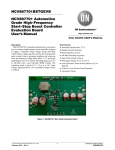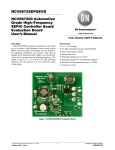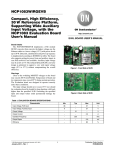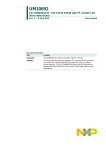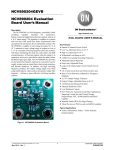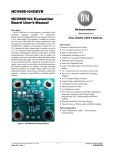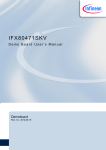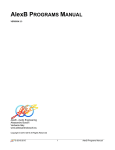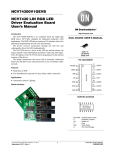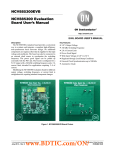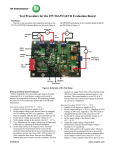Download NCV887601 Automotive Grade High-Frequency Start
Transcript
NCV887601BSTGEVB NCV887601 Automotive Grade High-Frequency Start-Stop Boost Controller Evaluation Board User'sManual http://onsemi.com EVAL BOARD USER’S MANUAL Description Key Features • • • • • • This NCV887601 evaluation board provides a convenient way to evaluate a high frequency boost controller designed to supply a minimum output voltage during Start-Stop vehicle battery voltage sags. The unit is in low Iq sleep-mode under normal battery operating condition and will wake-up when the monitored voltage drops below 7.3 V and begin regulating once 6.8 V is reached. Switching frequency is set to 440 kHz with a user selectable ROSC resistor. The evaluation board is rated 6.8 V / 3.6 A at a 2.6 V input voltage. Operation below 2.6 V is possible if output current is reduced. • • • Automatic enable below 7.3 V Boost Operation at 6.8 V 440 kHz Switching Frequency Input Undervoltage Lockout Wide Input Voltage of 2.6 V to 45 V Low Quiescent Current in Sleep Mode (<11 mA Typical) Cycle-by-Cycle Current Limit Protection Status Monitoring Automotive Grade Figure 1. NCV887601 Start−Stop Evaluation Board © Semiconductor Components Industries, LLC, 2013 October, 2013 − Rev. 3 1 Publication Order Number: EVBUM2200/D NCV887601BSTGEVB Table 1. EVALUATION BOARD TERMINALS Terminal Function VIN (large post) Positive DC input voltage (power) GND (large post) Common DC return (power) VOUT (large post) Regulated DC output voltage (power) GND (small post) Common DC return, monitoring point VC (small post) Voltage compensation, monitoring point VOUT (small post) Regulated DC output voltage, monitoring point VDRV (small post) Driving voltage, monitoring point STA (small post) IC status, monitoring point ISNS (small post) Current sense resistor voltage, monitoring point VG (small post) MOSFET gate voltage, monitoring point SW (small post) MOSFET drain voltage, monitoring point Table 2. ABSOLUTE MAXIMUM RATINGS (Voltages are with respect to GND) Rating Value Unit DC supply voltage (VIN) -0.3 to 45 V V DC supply voltage (EN, SYNC) -0.3 to 6 V V Junction Temperature -40 to 150 °C Ambient temperature (Evaluation Board) -40 to 105 °C Stresses exceeding Maximum Ratings may damage the device. Maximum Ratings are stress ratings only. Functional operation above the Recommended Operating Conditions is not implied. Extended exposure to stresses above the Recommended Operating Conditions may affect device reliability. Table 3. ELECTRICAL CHARACTERISTICS (TA = 25°C, 6 V ≤ VIN ≤ Vout_LED, VEN = 2 V, unless otherwise specified) Conditions Typical Value Unit ROSC = 10.7 kW 440 kHz ROSC (refer to datasheet) 170-500 kHz - 18 A - 0.83 - VOUT Undervoltage Lockout (UVLO) VOUT falling 3.6 V VOUT rising 4.0 Thermal Shutdown TA increasing 170 Characteristics Switching Switching Frequency User Selectable Frequency Range Current Limit Cycle-by-cycle Current Limit (FET) Protections Maximum Duty Cycle http://onsemi.com 2 °C NCV887601BSTGEVB Operational Guidelines 2. Limit time spent with the power supply operating at minimum input voltage (equivalent to VIN = 2.6 V) to avoid overheating the power semiconductors. The evaluation board is rated to operate at full load for input voltage as low as 2.6 V at the input terminal under full power (less if output current is reduced). Start-Stop applications use reverse battery protection diodes in front of the boost converter (Figure 2), so the input source can operate down to 2.6 V plus a diode drop (i.e ∼3 V). On the cathode side of the reverse battery protection diode, electrolytic capacitors are used (e.g. 2 x 330 mF) that serve three functions. 1. EMI filtering of the power supply input current. 2. Holdup energy to limit the Start-Stop operation dV/dt voltage sag to the boost supply. 3. When using a bench supply power source, the electrolytic capacitors decouple the power source from the boost demo board to prevent negative impedance oscillation*. * The use of external electrolytic capacitors at the input of the evaluation board (short leads) is strongly recommended for bench testing. First Time Power-Up: 1. Connect a DC2 input voltage (15 A capable) set to a voltage of 12.0 V as shown in Figure 2. DC1 is not used in this test. 2. Connect a 3.6 A load on the output. If a load resistor is used, it is recommended to start from a DC2 input voltage of 8.5-9.0 V to avoid overstressing the PCB boost diode (D1, rated 4 A). 3. Decrease the DC input voltage until the PCB VIN voltage is less than that that of the output. Verify that the unit is regulating at VOUT = 6.8 V. 4. Reduce the power source voltage until the PCB VIN = 2.6 V. Verify that the unit is regulating at VOUT = 6.8 V. Start-Stop Voltage Transient Test: 1. Connect both DC1 and DC2 input power supplies as illustrated in Figure 2. Adjust DC2 so that PCB VIN = 2.6 V for a 3.6 A load. 2. Connect a 3.6 A load on the output. If a load resistor is used, it is recommended to start from a DC1 input voltage of 8.5-9.0 V to avoid overstressing the PCB boost diode (D1, rated 4 A). 3. Monitor VOUT. Disconnect supply DC1. VOUT should have a response similar to that of Figure 3. Notes: 1. The IC UVLO (undervoltage lockout) is 4.0 V for VOUT rising, 3.6 V for VOUT falling (0.4 V hysteresis). The STATUS pin is powered by the IC VDRV pin on the demo board (details available from the Figure 4 schematic) to eliminate leakage current during normal battery operation. The STATUS pin has a high impedance state when in sleep-mode. STATUS pin is in a low impedance state only when the IC is awake (VOUT decreasing is below 7.3 V) and not in UVLO. Reverse Polarity Protection Diode VIN VOUT 470 μF + 220 μF DC1 (5 A capable) DC2 (15 A capable) 3.6 A Load Aluminum Electrolytics (LOCATE NEAR PCB, USE SHORT LEADS) GND Figure 2. Evaluation Board Connections http://onsemi.com 3 NCV887601 6.8 V / 3.6 A Evaluation Board GND NCV887601BSTGEVB Typical Performance DC1 is disabled, then re-enabled VOUT VIN VG **STATUS Figure 3. NCV887601 Evaluation Board Waveforms − DC2 at VIN set to 2.6 V (after reverse polarity protection diode) − VOUT = 6.8 V, IOUT = 3.6 A − **STATUS pin was powered using an external source http://onsemi.com 4 GND VIN C1 100nF C4 470pF VIN 2.2uH 5 http://onsemi.com R1 3.01K C5 33nF R2 10.7K NCV887601 SW STATUS R7 DNP ISNS R8 R9 0.022 0.022 C6 3300pF NRVB440MFS R6 VOUT 8.2 D1 VOUT C8 100uF 35V C9 100uF 35V C12 100nF Place cap close to VOUT terminal VOUT C11 1.0uF 50V VOUT Two 0.022 Ohms 1206 5% 1W resistors in parallel. D2 MM3Z3V3 MM3Z3V3ST1G R5 9.1K NVMFS5844NL Q1 GDRV GDRV R3 0 1 2 GND KLV1 ISNS R4 845 STATUS C14 100pF VSW VDRV ROSC 8 ROSC STATUS 1 IHLP5050FDER2R2M01 VDRV C2 U1 56uF C3 1uF 4 VDRV 5 VDRV GDRV C13 1.0uF 3 50V VOUT 6 VOUT GND VC 7 2 VC VC ISNS VIN L1 C10 100uF 35V C7 4.7uF 50V GND VOUT NCV887601BSTGEVB SCHEMATIC Figure 4. NCV887601 Boost 6.8 V / 3.6 A Evaluation Board Schematic NCV887601BSTGEVB BILL OF MATERIALS Table 4. BILL OF MATERIALS Reference Designator(s) QTY Description Value Tolerance C1, C12 2 CAP CER 0.1UF 50V 10% X7R 0805 100 nF 10% Murata Electronics North America GCM21BR71H104KA37L C2 1 CAP ALUM 56UF 50V 20% RADIAL 56 mF 20% Chemi-Con EKZE500ELL560MF11D C3 1 CAP CER 1UF 16V 10% X7R 0603 1 mF 10% Murata Electronics North America GCM188R71C105KA64D C4 1 CAP CER 470PF 50V 5% NP0 0603 470 pF 5% Murata Electronics North America GCM1885C1H471JA16D C5 1 CAP CER 0.033UF 50V 10% X7R 0603 0.033 mF 10% TDK Corporation CGA3E2X7R1H333K080AA C6 1 CAP CER 3300PF 50V 5% NP0 0603 3300 pF 5% TDK Corporation CGA3E2C0G1H332J080AA C7 1 CAP CER 4.7UF 50V 10% X7R 1206 4.7 mF 10% Taiyo Yuden UMK316AB7475KL-T C8, C9, C10 2 CAP ALUM 100UF 35V 20% SMD 100 mF 20% Nichicon RHS1V101MCN1GS C11 1 CAP CER 1UF 50V 10% X7R 1206 1.0 mF 10% Murata Electronics North America GCM31MR71H105KA55L C13 1 CAP CER 1UF 50V 10% X7R 0805 1.0 mF 10% TDK Corporation CGA4J3X7R1H105K125AB C14 1 CAP CER 100PF 50V 5% NP0 0603 100 pF 5% Murata Electronics North America GCM1885C1H101JA16D D1 1 40 V, 4.0 A Schottky Rectifier SO8-FL 40 V / 4A N/A ON Semiconductor NRVB440MFST1G D2 1 DIODE ZENER 3.3V 200MW SOD323 3.3 V / 200 mW N/A ON Semiconductor MM3Z3V3ST1G L1 1 INDUCTOR POWER 2.2UH 22A SMD 2.2 mH 20% Vishay Dale IHLP5050FDER2R2M01 Q1 1 N-Channel Power MOSFET 60V 61A SO-8FL 60 V / 61 A N/A ON Semiconductor NVMFS5844NL R1 1 RES 3.01K OHM 1/10W 1% 0603 SMD 3.01 KW 1% Vishay Dale CRCW06033K01FKEA R2 1 RES 10.7K OHM 1/10W 1% 0603 SMD 10.7 KW 1% Vishay Dale CRCW060310K7FKEA R3 1 RES 0.0 OHM 1/10W JUMP 0603 SMD 0 Jumper Vishay Dale CRCW06030000Z0EA R4 1 RES 845 OHM 1/10W 1% 0603 SMD 845 W 1% Vishay Dale CRCW0603845RFKEA R5 1 RES 9.10K OHM 1/10W 1% 0603 SMD 9.10 KW 1% Vishay Dale CRCW06039K10FKEA R6 1 RES 8.20 OHM 1/10W 1% 0603 SMD 8.2 W 1% Vishay Dale CRCW06038R20FKEA R8, R9 2 RES 0.022 OHM 1W 5% 1206 SMD 0.022 W 5% Panasonic Electronic Components ERJ-8BWJR022V R7 DNP TP1, 2, 3, 4 4 TERM SOLDER TURRET .219” .109”L N/A N/A Mill-Max Manufacturing Corp. 2501-2-00-44-00-00-07-0 TP5 thru TP17 13 PIN INBOARD .042” HOLE 1000/PKG N/A N/A Vector Electronics K24C/M U1 1 Automotive Non-Sync Boost Controller N/A N/A ON Semiconductor NCV887601 http://onsemi.com 6 Manufacturer Manufacturer’s Part Number NCV887601BSTGEVB PCB LAYOUT Figure 5. Top View (copper poor turned off) Figure 6. Bottom View (copper poor turned off) http://onsemi.com 7 NCV887601BSTGEVB ON Semiconductor and are registered trademarks of Semiconductor Components Industries, LLC (SCILLC). SCILLC owns the rights to a number of patents, trademarks, copyrights, trade secrets, and other intellectual property. A listing of SCILLC’s product/patent coverage may be accessed at www.onsemi.com/site/pdf/Patent−Marking.pdf. SCILLC reserves the right to make changes without further notice to any products herein. SCILLC makes no warranty, representation or guarantee regarding the suitability of its products for any particular purpose, nor does SCILLC assume any liability arising out of the application or use of any product or circuit, and specifically disclaims any and all liability, including without limitation special, consequential or incidental damages. “Typical” parameters which may be provided in SCILLC data sheets and/or specifications can and do vary in different applications and actual performance may vary over time. All operating parameters, including “Typicals” must be validated for each customer application by customer’s technical experts. SCILLC does not convey any license under its patent rights nor the rights of others. SCILLC products are not designed, intended, or authorized for use as components in systems intended for surgical implant into the body, or other applications intended to support or sustain life, or for any other application in which the failure of the SCILLC product could create a situation where personal injury or death may occur. Should Buyer purchase or use SCILLC products for any such unintended or unauthorized application, Buyer shall indemnify and hold SCILLC and its officers, employees, subsidiaries, affiliates, and distributors harmless against all claims, costs, damages, and expenses, and reasonable attorney fees arising out of, directly or indirectly, any claim of personal injury or death associated with such unintended or unauthorized use, even if such claim alleges that SCILLC was negligent regarding the design or manufacture of the part. SCILLC is an Equal Opportunity/Affirmative Action Employer. This literature is subject to all applicable copyright laws and is not for resale in any manner. PUBLICATION ORDERING INFORMATION LITERATURE FULFILLMENT: Literature Distribution Center for ON Semiconductor P.O. Box 5163, Denver, Colorado 80217 USA Phone: 303−675−2175 or 800−344−3860 Toll Free USA/Canada Fax: 303−675−2176 or 800−344−3867 Toll Free USA/Canada Email: [email protected] N. American Technical Support: 800−282−9855 Toll Free USA/Canada Europe, Middle East and Africa Technical Support: Phone: 421 33 790 2910 Japan Customer Focus Center Phone: 81−3−5817−1050 http://onsemi.com 8 ON Semiconductor Website: www.onsemi.com Order Literature: http://www.onsemi.com/orderlit For additional information, please contact your local Sales Representative EVBUM2200/D








